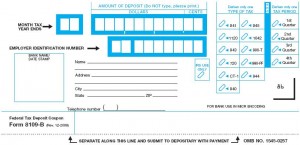Instead of the withholding-tax number reported on the Daily Treasury Statement (DTS), some analysts like to use the Social Security and Medicare taxes reported on the Monthly Treasury Statement (MTS) to analyze national employment trends. We don’t like that approach because those numbers are calculated from tax forms, rather than a simple bean-counting of actual dollars deposited into the Treasury Department’s bank account.
Social Security and Medicare taxes are listed separately on your paycheck, however when your employer pays his payroll taxes, he makes one payment. Take a look at this Form-8109 (click to enlarge):
There’s only one box to enter the amount deposited, right? All of the money goes to the Treasury Department. No money is paid directly to the Social Security Administration, or Medicare. Employers make such payments every business day, and the amount is reported on the “Withheld Income and Employment Taxes” line of the DTS.
At the end of the month, the Treasury Department publishes the MTS with a breakdown of the month’s revenue. The revenue apportioned to Social Security and Medicare can only be calculated from tax forms such as the 941. And the calculations are determined by law. For example, if you look at “Table 4” of the June 2010 MTS, you will see line-items for large “adjustments” and a footnote:
“In accordance with the Social Security Act as amended: ‘Individual income taxes, Withheld’ have been increased and ‘Federal Insurance Contribution Act Taxes’ correspondingly decreased by $9,173 million to correct estimates for the quarter ending June 30, 2009. ‘Individual income taxes, Other’ have been decreased and ‘Self-Employment Contribution Act Taxes’ correspondingly increased by $819 million to correct estimates for calendar year 2007 and prior.”
You never see anything like that on the DTS.
If the Social Security and Medicare taxes were paid in separate payments, then they would be excellent sources for studying trends in national employment. Unfortunately, those data are calculated rather than observed and thus, are not a pristine indicator of economic activity.
Examples
In the first half of 2010, Bruce Krasting (or here) and MaxedOutMama (or here) used Medicare data to draw bearish conclusions about the labor market. Those conclusions were contradicted by strong year-over-year growth in actual withholding-tax collections. And our view did indeed prevail as the labor market improved throughout 2010 – not to mention an historic stock market rally to go along with it.
Note: As of 2011, the Form 8109 shown above is no longer in use. The IRS now requires that employers make deposits electronically.
